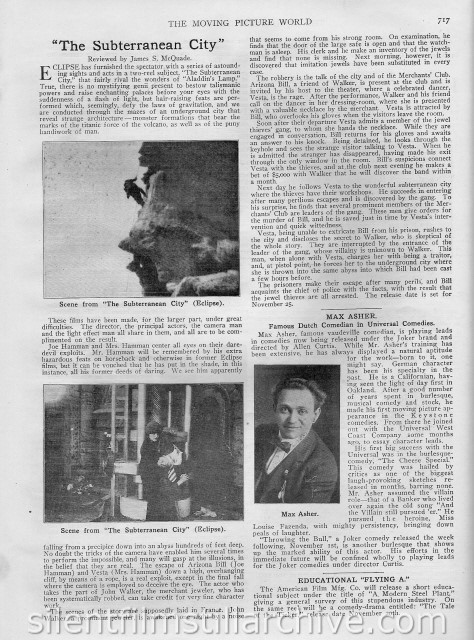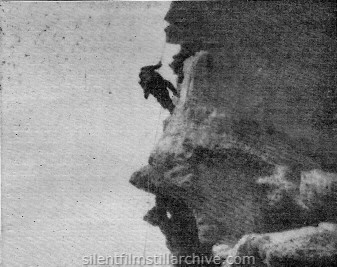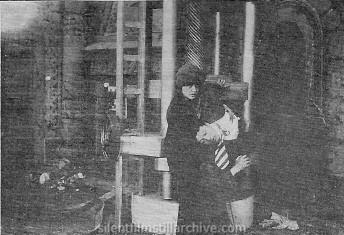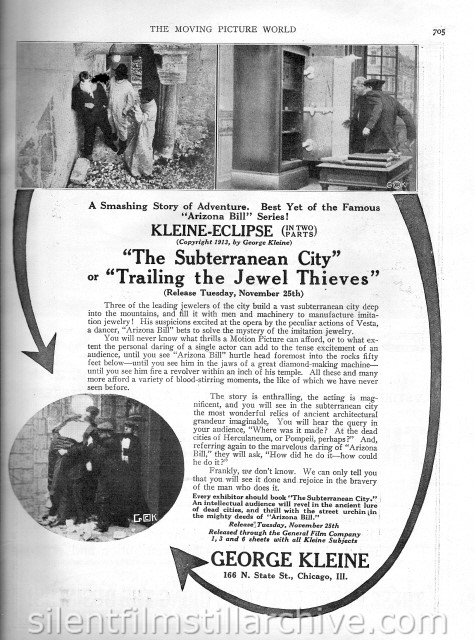![]()

The Subterranean City [La Ville Souterraine] (1913)

Moving Picture World, November 15, 1913, page 717
The Subterranean City
Reviewed by James S. McQuade.
Eclipse has furnished the spectator with a series of astounding sights and acts in a two-reel subject, "The Subterranean City," that fairly rival the wonders of "Aladdin's Lamp." True, there is no mystifying genii present to bestow talismanic powers and raise enchanting palaces before your eyes with the suddenness of a flash of light, but hair-raising feats are performed with, seemingly , defy the laws of gravitation, and we are conducted through the mazes of an underground city that reveal strange architecture -- monster formations that bear the marks of the titanic force of the volcano, as well as of the puny handiwork of man.

Scene from "The Subterranean City" (Eclipse).
These films have been made, for the larger part, under great difficulties. The director, the principal actors, the camera man and the lift effect man all share in them, and all are to be complimented on the result.
Joe Hamman and Mrs. Hamman center all eyes on their daredevil exploits. Mr. Hamman will be remembered by his extra hazardous feats on horseback and otherwise in former Eclipse films, but it can be vouched that he has put in the shade, in this instance, all his former deeds of daring. We see him apparently falling from a precipice down into the abyss hundreds of feet deep. No doubt the tricks of the camera hav enabled him several times to perform the impossible, and many will gasp at the illusions, in the belief that they are real. The escape of Arizone Bill (Joe Hamman) and Vesta (Mrs. Hamman) down a high, overhanging cliff, by means of a rope, is a real exploit, except in the final fall where the camera is employed to deceive the eye. The actor who takes the part of John Walker, the merchant jeweler, who has been systematically robbed, can take credit for very fine character work.

Scene from "The Subterranean City" (Eclipse).
The scenes of the story are supposedly laid in France. John Walker, a prominent jeweler, is awakened one night by a noise that seems to come from his strong room. On examination, he finds that the door of the large safe is open and that the watchman is asleep. His clerk and he make an inventory of the jewels and find that none is missing. Next morning, however, it is discovered that imitation jewels have been substituted in every case.
The robbery is the talk of the city and of the Merchants' Club. Arizone Bill, a friend of Walker, is present at the club and is invited by his host to the theater, where a celebrated dancer, Vesta, is the rage. After the performance, Walker and his friend call on the dancer in her dressing-room, where she is presented with a valuable necklace by the merchant. esta is attracted by Bill, who overlooks his gloves when the visitors leeave the room.
Soon after their departure Vesta admits a member of the jewel thieves' gang, to whom she hands the necklace. while they are engaged in conversation, Bill returns for his gloves and awaits an answer to his knock. Being detained, he looks through the keyhole and sees the strange visitor talking to Vesta. When he is admitted the stranger has disappeared, having made his exit throught the only window in the room. Bill's suspicions connect Vesta with the thieves, and at the club next evening he makes a bet of $5,000 with Walker that he will discover the band within a month.
Next day he follows Vesta to the wonderful subterranean city wiere the thieves have their workshops. He succeeds in entering after many perilous escapes and is discovered by the gang. To his surprise, he finds that several prominent members of the Merchants' Club are leaders of the gang. These men give orders for the murder of Bill, and he is saved just in time by Vesta's intervention and quick wittedness.
Vesta, being unable to extricate Bill from prison, rushes to the city and discloses the secret to Walker, who is skeptical of the whole story. They are interrupted by the entrance of the leader of the gang, whose villany is unknown to Walker. This man, when alone with Vesta, charges her with being a traitor, and, at pistol point, he forces her to the underground city where she is thrown into the same abyss into which Bill had been cast a few hours before.
The prisoners make their escape after many perils, and Bill acquaints the chief of police with the facts, with the result that the jewel thieves are all arrested. The release date is set for November 25th.

Moving Picture World, November 15, 1913, page 717
A Smashing Story of adventure. Best Yet of the Famous "Arizona Bill" Series!
KLEINE-ECLIPSE (IN TWO PARTS)
(Copyright 1913, by George Kleine)
"The Subterranean City" or "Trailing the Jewel Thieves"
(Release Tuesday, November 25th)
Three of the leading jewelers of the city build a vast subterranean city deep into the mountains, and fill it with men and machinery to manufacture imitation jewelry! His suspicions excited at the opera by the peculiar actions of Vesta, a dancer, "Arizona Bill" bets to solve the mystery of the imitation jewelry.
You will never know what thrills a Motion Picture can add to the tense excitement of an audience, until you see "Arizona Bill" hurtle head foremost into the rocks fifty feet below -- until you see him in the jaws of a great diamond-making machine -- until you see him fire a revolver within an inch of his temple. All these and many more afford a variety of blood-stirring moments, the like of which we have never seen before.
The story is enthralling, the acting is magnificent, and you will see in the subterranean city the most wonderful relics of ancient architectural grandeur imaginable. You will hear the query in your audience, "Where was it made? At the dead cities of Herculaneum, or Pompeii, perhaps?" And, referring again to the marvelous daring of "Arizona Bill," they will ask, "How did he do it -- how could he do it?"
Frankly, we don't know. We can only tell you that you will see it done and rejoice in the bravery of the man who does it.
Every exhibitor should book "The Subterranean City." An intellectual audience will revel in the ancient lure of dead cities, and thrill with the street urchin in the mighty deeds of "Arizona Bill."
Release Tuesday, November 25th
Released through the General Film Company
1, 3 and 6 sheets with all Kleine Subjects
GEORGE KLEINE
166 N. State St., Chicago, Ill.
with JoŽ Hamman, and Mrs. Hamman. Directed by JoŽ Hamman. Eclipse (France) / George Kleine (USA).
More Information on this film...

This work (The Subterranean City (1913), by
Eclipse/Kleine),
identified by
Bruce Calvert, is free of known copyright
restrictions.
Books
None.
Last Modified January 27, 2009.



















